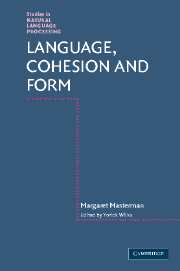Book contents
- Frontmatter
- Contents
- Preface
- Editor's introduction
- Part 1 Basic forms for language structure
- Part 2 The thesaurus as a tool for machine translation
- 4 The potentialities of a mechanical thesaurus
- 5 What is a thesaurus?
- Part 3 Experiments in machine translation
- Part 4 Phrasings, breath groups and text processing
- Part 5 Metaphor, analogy and the philosophy of science
- Bibliography of the scientific works of Margaret Masterman
- Other References
- Index
5 - What is a thesaurus?
Published online by Cambridge University Press: 22 September 2009
- Frontmatter
- Contents
- Preface
- Editor's introduction
- Part 1 Basic forms for language structure
- Part 2 The thesaurus as a tool for machine translation
- 4 The potentialities of a mechanical thesaurus
- 5 What is a thesaurus?
- Part 3 Experiments in machine translation
- Part 4 Phrasings, breath groups and text processing
- Part 5 Metaphor, analogy and the philosophy of science
- Bibliography of the scientific works of Margaret Masterman
- Other References
- Index
Summary
Introduction
Faced with the necessity of saying, in a finite space and in an extremely finite time, what I believe the thesaurus theory of language to be, I have decided on the following procedure.
First, I give, in logical and mathematical terms, what I believe to be the abstract outlines of the theory. This account may sound abstract, but it is being currently put to practical use. That is to say, with its help an actual thesaurus to be used for medium-scale mechanical translation (MT) tests, and consisting of specifications in terms of archeheads, heads and syntax markers, made upon words, is being constructed straight on to punched cards. The cards are multiply punched; a nuisance, but they have to be, since the thesaurus in question has 800 heads. There is also an engineering bottleneck about interpreting them; at present, if we wish to reproduce the pack, every reproduced card has to be written on by hand, which makes the reproduction an arduous business; a business also that will become more and more arduous as the pack grows larger. If this interpreting difficulty can be overcome, however, we hope to be able to offer to reproduce this punched-card thesaurus mechanically, as we finish it, for any other MT group that is interested, so that, at last, repeatable, thesauric translations (or mistranslations) can be obtained.
- Type
- Chapter
- Information
- Language, Cohesion and Form , pp. 107 - 146Publisher: Cambridge University PressPrint publication year: 2005
- 1
- Cited by

